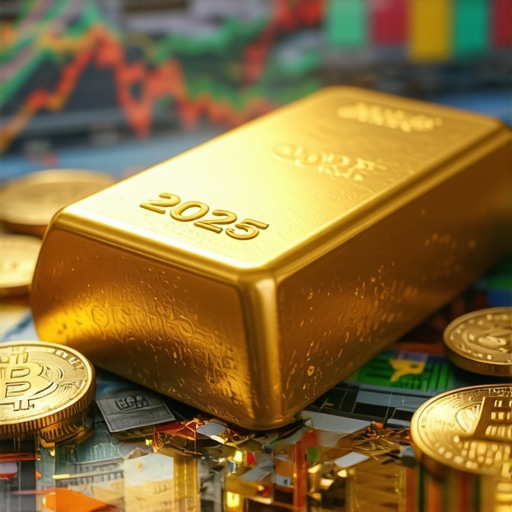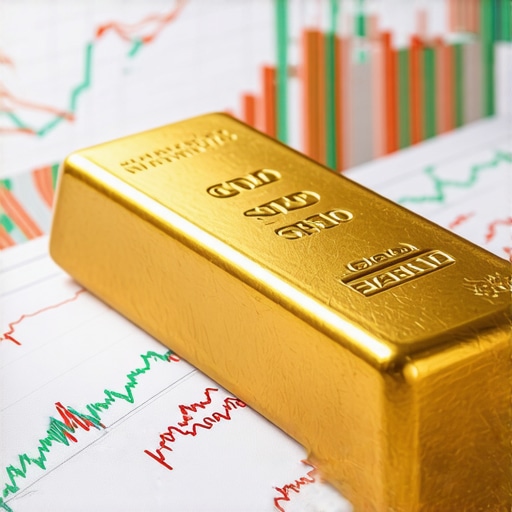Understanding Gold Supply: A Fundamental Pillar for Investors
The world of gold investment is both fascinating and complex. As an investor, grasping the intricacies of gold supply is crucial for making informed decisions. Gold supply refers to the total amount of gold available in the market, which includes newly mined gold and recycled gold from various sources. Understanding these dynamics can provide valuable insights into market trends and potential investment strategies.
Newly Mined Gold: The Primary Source
Newly mined gold forms the backbone of the global supply. Mining operations extract gold from the earth, and this process is influenced by various factors, including mining technology, geographical locations, and environmental regulations. Countries like China, Australia, and Russia are among the largest producers of gold, significantly impacting the overall market supply. Investors should keep an eye on production levels in these nations, as fluctuations can lead to changes in gold prices.
Recycled Gold: An Underestimated Contributor
Another critical aspect of gold supply is recycled gold, which comes from old jewelry, industrial applications, and other forms of gold that are processed back into the market. Recycling plays a significant role in maintaining a stable supply, especially during periods of high demand. In fact, during economic downturns, the recycling of gold often increases as individuals look to liquidate assets for cash. Understanding the impact of recycled gold on overall supply can help investors anticipate market movements.
Global Economic Factors Affecting Gold Supply
Several global economic factors can significantly influence gold supply. For instance, geopolitical tensions often lead to increased gold demand as investors seek safe-haven assets. Additionally, changes in central bank policies can affect gold production and sales. Central banks hold large reserves of gold and their buying or selling activities can create ripples in the market. For more comprehensive insights into how central banks affect gold prices, check out our post on how central banks affect gold prices today.
Importance of Understanding Gold Supply for Investors
As an investor, understanding gold supply is essential for crafting a robust investment strategy. Knowledge of how supply fluctuations can impact prices allows investors to make timely decisions. For example, if newly mined gold production declines while demand remains steady or increases, prices are likely to rise. Conversely, an oversupply can lead to price drops. By analyzing gold demand trends and supply dynamics, investors can position themselves advantageously in the market. For further reading, explore our article on analyzing gold demand trends for key takeaways that can enhance your investment approach.
In conclusion, understanding the factors that drive gold supply is vital for any investor seeking to navigate the complexities of the gold market. By staying informed about mining activities, recycling trends, and global economic changes, investors can make more educated decisions that align with their financial goals.
Exploring Gold Demand: Insights for Savvy Investors
As we delve deeper into the dynamics of gold investment, understanding gold demand becomes equally critical as knowing the supply. Gold demand encompasses the amount of gold that consumers, investors, and industries require, influencing its market price significantly. Recognizing the factors that drive demand can empower investors to make well-informed choices.
Consumer Demand: Jewelry and Beyond
A substantial portion of global gold demand arises from the jewelry sector. Countries like India and China lead the world in gold jewelry consumption, particularly during festivals and weddings. In addition to jewelry, gold is also sought after for its aesthetic appeal and cultural significance. With the rise of disposable income levels in emerging markets, the demand for gold jewelry is expected to continue its upward trajectory. Investors should monitor trends in consumer behavior and economic conditions in these key markets to predict potential shifts in demand.
Investment Demand: A Safe Haven Asset
In times of economic uncertainty, gold often becomes a preferred choice for investors looking to safeguard their assets. This investment demand can manifest through physical gold purchases, such as bullion and coins, as well as through financial products like gold ETFs and mutual funds. As highlighted in our post on the basics of investing in gold mutual funds, these financial instruments offer investors a convenient way to gain exposure to gold without holding the physical metal. The demand for gold as a safe haven is particularly pronounced during geopolitical tensions, inflationary periods, or stock market volatility.
Industrial Demand: Gold in Technology
Beyond jewelry and investment, gold has significant industrial applications. It is widely used in electronics, telecommunications, and even medical devices due to its excellent conductivity and resistance to tarnish. As technology continues to advance, the industrial demand for gold is expected to grow, making it an essential factor for investors to consider. Understanding how technological advancements influence gold demand can provide a competitive edge in the investment landscape.
Global Economic Indicators Impacting Gold Demand
Several global economic indicators can impact gold demand. For example, rising inflation often leads to increased interest in gold as a hedge against currency devaluation. Additionally, interest rates play a crucial role; lower rates can boost gold demand as the opportunity cost of holding gold diminishes. For insights on how central banks affect gold prices, refer to our article on how central banks affect gold prices today. By keeping an eye on these economic indicators, investors can better anticipate shifts in demand.
Long-Term Projections: The Future of Gold Demand
As we look towards the future, understanding long-term demand trends is vital for investors. Factors such as population growth, urbanization, and changing consumer preferences will shape the gold market dynamics. For instance, if more individuals in developing nations begin to invest in gold, it could lead to a significant increase in demand. Staying informed about these trends can help investors position themselves strategically in the evolving market landscape.
In summary, a comprehensive understanding of gold demand is essential for investors aiming to navigate the complexities of the gold market effectively. By analyzing consumer trends, investment behaviors, and industrial applications, investors can gain invaluable insights that inform their strategies. For more detailed guidance, consider exploring our post on investing in gold: a guide to gold-backed investments to enhance your investment knowledge.
Factors Influencing Gold Demand: A Deep Dive
To truly grasp the intricacies of gold demand, one must consider the various factors that influence it. Economic stability, geopolitical tensions, and changes in consumer behavior all play pivotal roles. Additionally, the rising trend of sustainability and ethical sourcing is reshaping how consumers and investors approach gold. As the market evolves, staying informed about these elements can provide a competitive edge for investors.
Geopolitical Tensions: The Role of Global Unrest
During times of geopolitical instability, gold often becomes a refuge for investors. Events such as wars, trade disputes, and political unrest can lead to a surge in demand as individuals and institutions seek to secure their wealth. Understanding how these factors correlate with gold prices is crucial for making informed investment decisions. For insights on gold price forecasts, refer to our analytical posts that explore market predictions.
Technological Advancements: The New Frontier of Gold Demand
As industries evolve, so too does the demand for gold. The emergence of new technologies in electronics, renewable energy, and healthcare is driving up the need for gold in innovative applications. From advanced circuitry in smartphones to medical devices that utilize gold for its biocompatibility, the industrial demand continues to flourish. Investors should remain abreast of these technological trends to anticipate shifts in the market.
Changing Consumer Preferences: A Shift Towards Ethical Investing
The modern consumer is more discerning than ever, often prioritizing ethical sourcing and sustainability in their purchasing decisions. This shift is influencing gold demand, particularly among younger investors who are more likely to seek out ethically mined gold. As awareness of environmental issues grows, companies that adopt sustainable practices will likely see increased demand for their products. Understanding these trends is essential for investors looking to align their portfolios with consumer values.
Economic Indicators: Monitoring Market Sentiment
Economic indicators, such as GDP growth rates, unemployment figures, and consumer confidence indexes, are critical in predicting gold demand. For instance, a rise in unemployment may lead to greater interest in gold as a secure investment option. Keeping an eye on these indicators can help investors understand market sentiment and adjust their strategies accordingly. Our article on the correlation between gold and stocks offers further insights into how economic shifts can influence gold prices.
Long-Term Demand Trends: Preparing for the Future
Looking ahead, various long-term trends suggest that gold demand will continue to evolve. Factors such as urbanization, population growth, and increased wealth in developing countries will likely drive demand higher. In particular, the growing middle class in emerging economies is expected to contribute significantly to gold consumption. Investors should consider these demographics when evaluating their gold investment strategies.
In conclusion, understanding the multifaceted nature of gold demand is integral for any serious investor. By analyzing geopolitical factors, technological advancements, consumer preferences, and economic indicators, investors can develop a well-rounded approach to navigating the gold market. For a comprehensive guide on gold investment strategies, be sure to explore our extensive resources tailored for investors at every level.
Investment Strategies: Capitalizing on Gold Demand Trends
As the factors influencing gold demand continue to evolve, so too must the strategies employed by investors. Understanding these trends is essential not only for making informed decisions but also for optimizing investment portfolios. By focusing on various aspects of gold demand, investors can tailor their approaches to better meet market conditions.
Understanding Market Cycles: Timing Your Investments
Investment in gold is often cyclical, influenced by economic conditions and market sentiment. Recognizing these cycles can enable investors to time their purchases effectively. During periods of economic downturn or uncertainty, gold traditionally sees an uptick in demand as investors flock to safe-haven assets. Conversely, during times of prosperity, demand may wane. For a deeper exploration of how gold prices fluctuate with market conditions, check out our detailed analysis.
Diversification: Integrating Gold into Your Portfolio
Gold is not just a standalone investment; it plays a pivotal role in portfolio diversification. By including gold in a broader investment mix, investors can hedge against volatility in other markets. Whether through physical gold, gold ETFs, or gold stocks, incorporating this precious metal offers stability and potential growth opportunities. For insights on gold ETFs and their benefits, explore our dedicated guide.
Monitoring Global Economic Indicators: A Key to Success
Investors must stay informed about global economic indicators that can affect gold demand. Key metrics like inflation rates, interest rates, and currency fluctuations can provide clues about future gold price movements. For instance, rising inflation typically boosts the allure of gold as a hedge against currency devaluation. Keeping abreast of these indicators will equip investors with the knowledge needed to navigate the complexities of the gold market.
Ethical Investment: Aligning with Consumer Values
As consumer preferences shift towards ethical and sustainable investing, understanding the implications for gold demand is crucial. Investors should consider companies that prioritize responsible sourcing and environmental sustainability in their operations. This alignment with ethical standards not only meets consumer demands but can also enhance long-term brand loyalty and market performance. For further exploration of ethical gold investments, refer to our article on gold coins as an investment choice.
Future Outlook: Anticipating Gold Demand Changes
Looking ahead, several trends suggest that gold demand will continue to experience shifts. The rise of digital gold options, such as cryptocurrencies backed by gold, and the increasing interest in gold as a retirement investment vehicle could reshape the market landscape. Investors should keep an eye on these emerging trends to adapt their strategies accordingly. For a comprehensive overview of setting up a Gold IRA, our guide provides essential insights for those considering this investment route.
In conclusion, staying informed about the multifaceted factors influencing gold demand is crucial for investors. By embracing strategic investment approaches, monitoring market indicators, and aligning with ethical practices, one can navigate the gold market effectively. For more resources on gold investment strategies, dive into our extensive content tailored for investors at every level.
Frequently Asked Questions About Gold Investment
What factors influence gold prices?
Gold prices are influenced by a variety of factors including inflation rates, interest rates, geopolitical tensions, and currency fluctuations. Understanding these factors is essential for making informed investment decisions.
Is investing in gold a good idea?
Investing in gold can be a wise decision, especially during economic uncertainty. Gold serves as a hedge against inflation and currency devaluation, making it a stable investment option. However, it’s important to consider your overall investment strategy and risk tolerance.
How can I invest in gold?
There are several ways to invest in gold, including purchasing physical gold (jewelry, coins, or bullion), investing in gold ETFs, buying shares in gold mining companies, or through gold mutual funds. Each method has its own benefits and risks, so it’s crucial to evaluate which option aligns with your investment goals.
What is a Gold IRA?
A Gold IRA is a type of individual retirement account that allows investors to hold physical gold or other precious metals as part of their retirement portfolio. This can provide tax advantages and diversification for your retirement savings. For those considering this option, it’s advisable to consult a financial advisor.
Are gold ETFs a better investment than physical gold?
Gold ETFs offer several advantages over physical gold, including ease of trading, lower storage costs, and liquidity. However, physical gold provides tangible ownership and can be a safer investment during market volatility. Depending on your goals, one may be better suited for you than the other.
What are the risks of investing in gold?
While gold is often seen as a safe-haven asset, it is not without risks. Price volatility, lack of income generation (such as dividends), and potential storage costs are factors to consider. Additionally, market demand can fluctuate, impacting gold prices significantly.
How do I choose the best gold investment strategy?
Choosing the best gold investment strategy depends on your financial goals, risk tolerance, and investment horizon. Assessing your current portfolio, understanding market conditions, and considering diversification strategies are key steps in developing a tailored approach to gold investment.
What is the future outlook for gold investments?
The future outlook for gold investments appears promising, especially with ongoing economic uncertainty and rising inflation. Emerging trends such as digital currency and increased interest in sustainable investments may also shape the market. Staying informed and adaptable is crucial for success in gold investing.
Can I invest in gold if I’m a beginner?
Absolutely! Beginners can start investing in gold by purchasing smaller quantities of physical gold, investing in gold ETFs, or through gold mutual funds. It’s important to educate yourself about the market and consider starting with a small investment to gain experience.
Authority Resources for Gold Investment
For those looking to deepen their understanding of gold investments, the following resources are highly recommended:
- Investopedia – Ultimate Guide to Gold Investing
- World Gold Council – Official Site for Gold Market Trends and Insights
- Kitco – Precious Metals Market News and Analysis
- Federal Reserve – Economic Data and Research on Inflation and Interest Rates
- BullionVault – Buying and Selling Gold Online
- Forbes – Comprehensive Guide on Gold Investing
Conclusion: Your Path to Gold Investment Success
In conclusion, understanding the multifaceted factors influencing gold demand is crucial for investors. By embracing strategic investment approaches, monitoring market indicators, and aligning with ethical practices, you can navigate the gold market effectively. Whether you choose physical gold, ETFs, or stocks, the key to successful gold investment lies in staying informed and adaptable to market changes. For more resources on gold investment strategies, dive into our extensive content tailored for investors at every level.











I found the distinction between newly mined gold and recycled gold particularly eye-opening. It’s easy to overlook how recycled gold contributes significantly to the supply, especially during economic downturns when people tend to liquidate their gold assets. It makes me wonder how fluctuations in recycling rates might signal upcoming shifts in gold prices. In my experience, many investors focus solely on mining outputs and neglect to factor in the dynamics of recycled gold, which can provide a buffer or amplify supply changes depending on economic conditions. For those actively investing, it seems crucial to monitor both mining reports and recycling trends to get a full picture of supply-side pressures. Additionally, considering geopolitical events and central bank activities adds layers of complexity but also opportunity. Has anyone else found effective sources or indicators that track recycled gold flows or perhaps innovative ways to gauge this less transparent segment of gold supply? It would be fascinating to hear different approaches to integrating this knowledge into investment strategies.